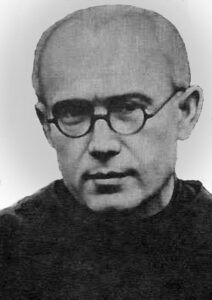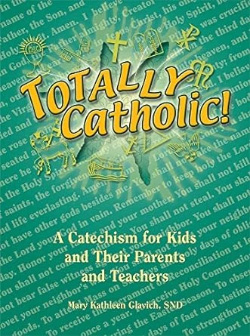 I’m working on a project for an amateur radio operator who discovered that his hobby had a patron saint. In the process, I realized that this saint would also make a good patron saint for me: St. Maximilian Kolbe. For one thing he is Polish, and so was my mother. Second, he had a profound love for our Blessed Mother, and I am a Sister of Notre Dame. Third, he was devoted to publishing material to promote the Gospel, and so am I. If you are not familiar with this extraordinary saint, let me introduce you to him. He was canonized in 1982, surprisingly as a “martyr of charity.” He died, not in defense of the faith, but by volunteering to die in place of another prisoner at Auschwitz. His entire life, though, was one of heroic virtue.
I’m working on a project for an amateur radio operator who discovered that his hobby had a patron saint. In the process, I realized that this saint would also make a good patron saint for me: St. Maximilian Kolbe. For one thing he is Polish, and so was my mother. Second, he had a profound love for our Blessed Mother, and I am a Sister of Notre Dame. Third, he was devoted to publishing material to promote the Gospel, and so am I. If you are not familiar with this extraordinary saint, let me introduce you to him. He was canonized in 1982, surprisingly as a “martyr of charity.” He died, not in defense of the faith, but by volunteering to die in place of another prisoner at Auschwitz. His entire life, though, was one of heroic virtue.
St. Maximilian Kolbe was born in occupied Poland in 1894 and named Raymond. He was a normal, mischievous boy until after one escapade his mother sighed and said, “What will become of you?” Raymond, who was raised to have a strong devotion to the Mother of God, went to church and prayed before her statue. His mother’s distress and words had a profound impact on him. Years later she disclosed that while praying that day, Raymond had a vision of the Virgin Mary holding a white crown for purity and a red one for martyrdom. Mary asked the boy to choose, and he chose both. Although he desired to fight to free Poland, eventually he became a Franciscan priest and became a knight not for Poland but for the Blessed Mother. He was a genius who excelled in math and science and obtained two doctorates in Rome. One professor remarked that he could have won a Nobel prize if he hadn’t chosen to become a priest.
In Rome, Max was afflicted with tuberculosis, a disease he battled for the rest of his life. But ill health did not prevent him from promoting the Gospel. While still studying, he began an organization whose members were devoted to Mary. It was called Militia Immaculatae (Knights of the Immaculate) and grew to thousands of members. Back in Poland, with the help of divine providence he overcame many obstacles (like the resistance of his community) and successfully printed a newspaper referred to as The Knight. He succeeded in setting up a printing house where dozens of friars were employed publishing this paper and other religious material. It blossomed into the complex of many buildings and became a large monastery with a seminary and a virtual city named Niepokalano (City of Mary). Father Kolbe’s zeal drove him to establish a similar undertaking in Japan called Garden of Mary. The friars constructed the buildings under adverse conditions, and Father Kolbe led them in enduring the hard labor and miserable weather, despite his illness. Always progressive, Father Kolbe set up a radio station and planned to make films too.
After Germany invaded Poland, all priests became targets, in particular, Father Kolbe, who was the publisher of material that was sometimes critical of the Nazi philosophy. Father Kolbe and his friars were arrested and taken to an internment camp hundreds of miles away. After three months they were released. As Poland was attacked, the Franciscans at the City of Mary took in hundreds of refugees, feeding them and treating them in their infirmary. They also built an orphanage that in the end housed a thousand children.
One day in 1941, the Gestapo came for Fr. Kolbe and four other priests who were involved in the publications and taken to Piawak prison. There Fr. Kolbe ministered to the other prisoners and contracted pneumonia. Later, he was herded into cattle cars with hundred of other prisoners and transported to Auschwitz. I will spare you the descriptions of the atrocious conditions and the inhuman treatment Fr. Kolbe was subjected to at the prison and the concentration camp.
In the end, one prisoner from Fr. Kolbe’s bunker had escaped. The punishment was that ten prisoners would be sent to the starvation bunker to die. The Commandant cruelly chose ten victims. One man selected cried out that he had a wife and children. Fr. Kolbe stepped forward and said he would take the man’s place. In the starvation bunker, Fr. Kolbe kept up the spirits of the other prisoners, leading them in prayers and hymns. When only four men were still alive, it was decided to inject them with carbolic acid. Fr. Kolbe, the only one fully conscious, held out his arm for the lethal injection.
At Fr. Kolbe’s canonization, the man whose life he had saved was present.
This is only a sketchy biography. I encourage you to read more about this unusual man.
Do you have a special patron saint? If so, who is it and why do you have a special devotion to him or her?
 BOOK REVIEW: Forgiving Mother: A Marian Novena of Healing and Peace
BOOK REVIEW: Forgiving Mother: A Marian Novena of Healing and Peace
Marge Steinhage Fenelon
Recently non-native speakers were asked in a poll to name the most beautiful English word. Most of them responded, “mother.” However, not everyone enjoys a good relationship with his or her mother. Some mothers are uncaring and even abusive, sometimes because of bad experiences with their own parents. Being deprived of a mother’s love leads to a host of problems, such as suffering, guilt, anger, and a lack of self-worth. Realizing that a number of people are estranged from their mothers, Fenelon wrote this book to offer help. She speaks from personal experience, frankly recounting times her mentally ill and abusive mother treated her cruelly. This makes for uncomfortable reading. However, Fenelon explains that she reveals these “family secrets” to show her readers that she knows what they are going through.
The paramount advice the author offers is to look to our Blessed Mother and take comfort in her tender love and help. (My own book Heart to Heart with Mary cultivates this practice and would make a good resource for those in need of a mother’s love.) Fenelon traces the development of her relationship with Mary, dwelling on her involvement with the Schoenstatt Movement, its founder, and consecration to Mary. She presents St. Germaine as an example of grace at work. In the course of the book, she offers practical advice and shares her wisdom. The reader finds answers to questions such as how do you deal with painful memories? How do you forgive?
Before Fenelon’s mother dies, they are reconciled and Fenelon is healed. The book concludes with a novena based on the wisdom offered in each of its nine chapters. Each day of the novena begins with an introduction followed by a Gospel passage for meditation. Commentary on the passage and how it is linked with subject of the book is next. Then several questions for pondering are suggested. These questions may be the basis for prayer with Jesus or answered in writing in a journal. The day concludes with a prayer to Jesus or Mary and a rosary prayed for a particular grace or intention.
In its gentle, personal way, this book can be a boon to anyone who bears painful wounds from an unhealthy relationship with a mother or stepmother.








